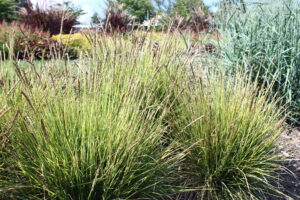Autumn moor grass
* Common name: Autumn moor grass

The flower spikes and foliage of autumn moor grass in mid-fall.
* Botanical name: Sesleria autumnalis
* What it is: Autumn moor grass is a European native ornamental grass that grows in foot-tall clumps.
For most of the year, it’s a utilitarian plant used primarily as a grassy groundcover. But come fall, its greenish flower spikes turn a silvery white at the same time the foliage morphs from green to yellow-green. The spikes ultimately turn tan to end the season.
Like most ornamental grasses, autumn moor grass seldom runs into bug or disease issues, and deer and other animals don’t like it.
* Size: Foliage clumps grow about a foot tall. The flower spikes go up another six inches. Space plants two feet apart.
* Where to use: Autumn moor grass grows in full sun to partly shaded locations in average to dry soil. Once established, it’s reasonably drought-tough. The main condition it doesn’t like is high heat and humidity, so use it in any cooler microclimates you have around the yard.
This grass works best massed or as a groundcover as opposed to the singular and specimen uses of taller grasses.
* Care: Keep soil consistently damp the first year to help establish the roots, then soak occasionally during hot, dry spells. Fertilizer is usually not needed.
Cut browned-out plants to a stub in March (or any time over winter). If clumps spread where you don’t want them, dig, divide, and plant fist-sized pieces elsewhere.
* Great partner: None needed if you’re using moor grass as a low-care, grass-like lawn alternative. Otherwise, mass it under and around tall shrubs, such as viburnum, lilac, ninebark, winterberry holly, and panicle hydrangeas.







